Note the pitot tube on the left wing and the small wingtip skids
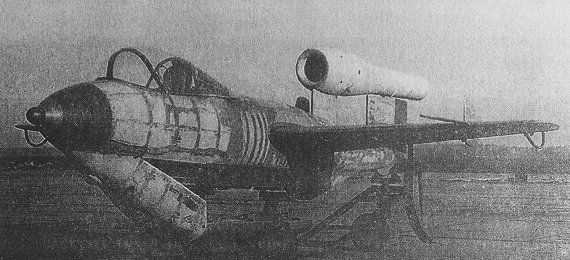
Junkers Ju EF126 windtunnel models
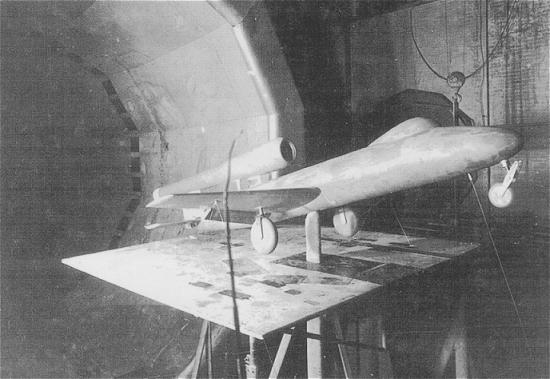
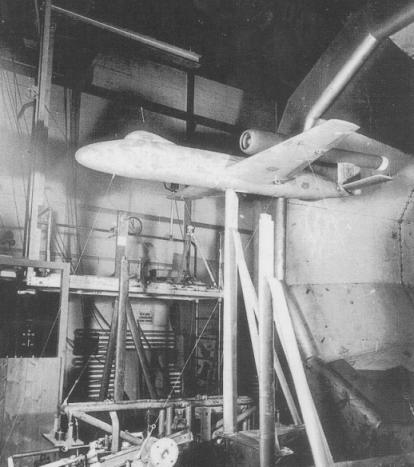
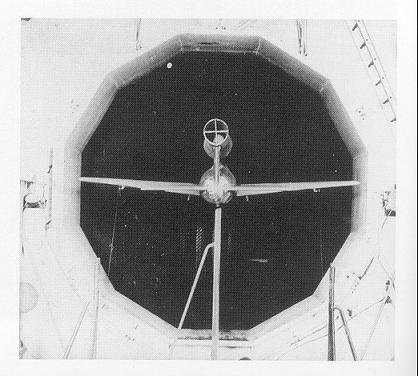
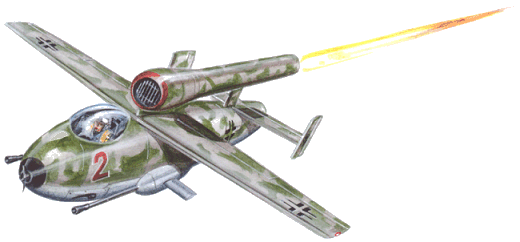
Junkers Ju EF126 shoulder-mounted wing version

Junkers Ju EF126 midfuselage-mounted wing version
Above color illustrations from Geheimprojekte der Luftwaffe Band III - Schlachtflugzeuge und Kampfzerstörer 1935-1945
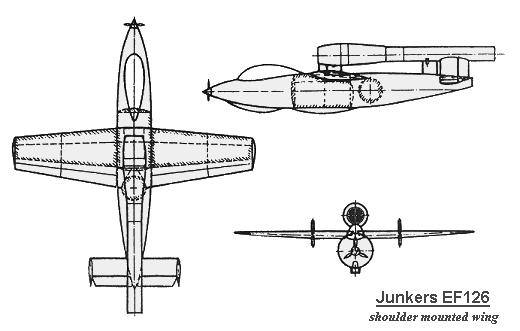 (Miniature Fighter) program was to use the simplest and cheapest power
plant available, and to have the minimum of strategic materials and practically
no electrical equipment. The motive power chosen was to be the Argus As
014 pulse jet, the same power used for the Fi 103 Buzz Bomb (V1), and the
Miniaturjäger was to takeoff and land conventionally. The plan
was to be able to build a large numbers of these aircraft, and thus simply
overwhelm the enemy bomber formations with their numbers. Only three firms
participated in this design competition, Heinkel (with a pulse jet powered
He 162 airframe), Blohm & Voss (BV P.213
) and Junkers. Junkers had been working on the EF126 since early
1944 and it fit the Miniaturjäger requirements issued later
that year. It was calculated that the cost of a completed Ju EF126 aircraft
would be 30,000 Reich marks, compared to 74,000 for a completed Heinkel
He 162 jet fighter or 150,000 Reich marks for a Messerschmitt Me 262.
(Miniature Fighter) program was to use the simplest and cheapest power
plant available, and to have the minimum of strategic materials and practically
no electrical equipment. The motive power chosen was to be the Argus As
014 pulse jet, the same power used for the Fi 103 Buzz Bomb (V1), and the
Miniaturjäger was to takeoff and land conventionally. The plan
was to be able to build a large numbers of these aircraft, and thus simply
overwhelm the enemy bomber formations with their numbers. Only three firms
participated in this design competition, Heinkel (with a pulse jet powered
He 162 airframe), Blohm & Voss (BV P.213
) and Junkers. Junkers had been working on the EF126 since early
1944 and it fit the Miniaturjäger requirements issued later
that year. It was calculated that the cost of a completed Ju EF126 aircraft
would be 30,000 Reich marks, compared to 74,000 for a completed Heinkel
He 162 jet fighter or 150,000 Reich marks for a Messerschmitt Me 262.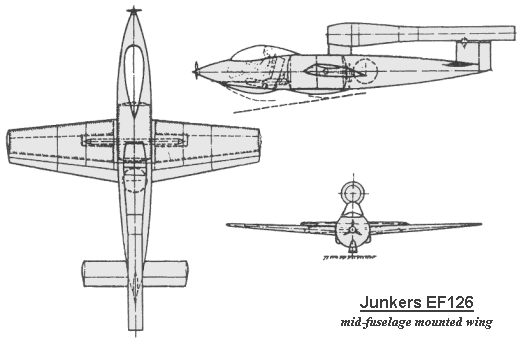 shoulder-mounted wing with twin fins on the ends of the tail planes
and a midfuselage-mounted wing with a more standard tail configuration.
A single Argus As 109-044 pulse jet engine that developed 500 kg (1102
lbs) of thrust was mounted on the top of the fuselage in both versions.
Since a pulse jet must be brought up to its operating speed, takeoff was
achieved by the use of two detachable solid-fuel rockets with 1200
kg (2640 lbs) thrust. Originally, a tricycle landing gear system was envisioned,
but to save weight and design time takeoff was to be on a droppable takeoff
dolly and landing was to take place on a retractable landing skid. A small
propeller on the fuselage nose powered the generator until the aircraft
was brought up to speed. The pilot sat under a bubble canopy located in the
fuselage nose that afforded good all around vision. Armament consisted of
two MG 151/20 20mm forward firing fixed cannon (with 180 rounds each) mounted
on the fuselage sides. In addition, the EF126 could also carry 24 R4M unguided
rockets beneath the wings. Since the Argus pulse jet engine's performance
worsened with altitude, the EF126 was also to be used in the ground attack
role, where an auxiliary load of 400 kg (880 lbs) could be carried beneath
the wings.
shoulder-mounted wing with twin fins on the ends of the tail planes
and a midfuselage-mounted wing with a more standard tail configuration.
A single Argus As 109-044 pulse jet engine that developed 500 kg (1102
lbs) of thrust was mounted on the top of the fuselage in both versions.
Since a pulse jet must be brought up to its operating speed, takeoff was
achieved by the use of two detachable solid-fuel rockets with 1200
kg (2640 lbs) thrust. Originally, a tricycle landing gear system was envisioned,
but to save weight and design time takeoff was to be on a droppable takeoff
dolly and landing was to take place on a retractable landing skid. A small
propeller on the fuselage nose powered the generator until the aircraft
was brought up to speed. The pilot sat under a bubble canopy located in the
fuselage nose that afforded good all around vision. Armament consisted of
two MG 151/20 20mm forward firing fixed cannon (with 180 rounds each) mounted
on the fuselage sides. In addition, the EF126 could also carry 24 R4M unguided
rockets beneath the wings. Since the Argus pulse jet engine's performance
worsened with altitude, the EF126 was also to be used in the ground attack
role, where an auxiliary load of 400 kg (880 lbs) could be carried beneath
the wings. they were tested under the management of test engineer Heinrich
Hartmann together with the aircraft crew Heinrich Schreiber, Paul Heerling
and two other engineers. During the first test flight on December 31, 1946
a very disagreeable low frequency resonance effect was observed, which eventually
led to damage of the fuselage structure of the Ju 88 test bed. Some nasty
incidents also occurred during later test flights. On Feb. 19, 1947, the
fuel line for the Jumo 226, inside the Ju 88 fuselage, broke as a result
of excessive vibration. The resulting fuel vapors made an immediate emergency
landing at Ramenskoje necessary. After about 50 test flights, a final high
altitude test on May 30, 1947 was to confirm the operational capability
of the pulse jet at an altitude of 5,000 m (16,404 ft). After a spectacular
takeoff, with the help of the Jumo 226, the right-hand Ju 88G-6 engine caught
fire. The flight ended with a crash landing that put the aircraft out of
action until the autumn of 1947.
they were tested under the management of test engineer Heinrich
Hartmann together with the aircraft crew Heinrich Schreiber, Paul Heerling
and two other engineers. During the first test flight on December 31, 1946
a very disagreeable low frequency resonance effect was observed, which eventually
led to damage of the fuselage structure of the Ju 88 test bed. Some nasty
incidents also occurred during later test flights. On Feb. 19, 1947, the
fuel line for the Jumo 226, inside the Ju 88 fuselage, broke as a result
of excessive vibration. The resulting fuel vapors made an immediate emergency
landing at Ramenskoje necessary. After about 50 test flights, a final high
altitude test on May 30, 1947 was to confirm the operational capability
of the pulse jet at an altitude of 5,000 m (16,404 ft). After a spectacular
takeoff, with the help of the Jumo 226, the right-hand Ju 88G-6 engine caught
fire. The flight ended with a crash landing that put the aircraft out of
action until the autumn of 1947.